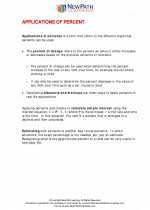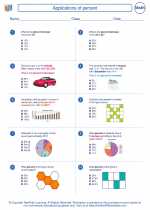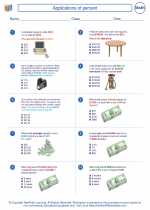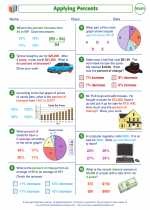Applications of Percent
Percentages are used in many real-life situations, such as calculating discounts, interest rates, taxes, and tips. Understanding how to work with percentages is an important skill in everyday life and in various fields such as finance, business, and science.
Percentages and Fractions
A percentage is a way of expressing a number as a fraction of 100. To convert a percentage to a fraction, you can simply place the percentage value over 100 and simplify, if possible.
For example, 25% can be written as 25/100, which simplifies to 1/4.
Finding the Percent of a Number
To find a certain percentage of a number, you can multiply the number by the decimal equivalent of the percentage. To convert a percentage to a decimal, divide it by 100.
For example, to find 20% of 80, you would calculate 80 * 0.20 = 16.
Calculating Percent Increase or Decrease
To calculate percent increase or decrease, you would first find the difference between the new and old values, then divide that difference by the original value and multiply by 100.
For example, if a shirt originally cost $40 and is now on sale for $30, the percent decrease would be ((40-30)/40) * 100 = 25%.
Discounts and Markups
When dealing with discounts or markups, the amount of the discount or markup is calculated as a percentage of the original price. For a discount, you subtract the discount amount from the original price, and for a markup, you add the markup amount to the original price.
Interest and Taxes
Interest rates on loans or savings accounts are often expressed as annual percentages. To calculate the interest on a loan or savings, you would use the formula: Interest = Principal * Rate * Time.
Taxes are also often calculated as a percentage of income or the cost of goods and services.
Study Guide
- Understand the relationship between percentages and fractions.
- Be able to find the percent of a number by converting the percentage to a decimal and multiplying.
- Practice calculating percent increase or decrease using the appropriate formula.
- Learn how to calculate discounts and markups using percentages.
- Study the application of percentages in interest and taxes.
By mastering the applications of percent, you'll be better equipped to handle real-life mathematical problems and make informed decisions in various situations.
.◂Math Worksheets and Study Guides Eighth Grade. Applications of percent

 Worksheet/Answer key
Worksheet/Answer key
 Worksheet/Answer key
Worksheet/Answer key
 Worksheet/Answer key
Worksheet/Answer key
 Worksheet/Answer key
Worksheet/Answer key
